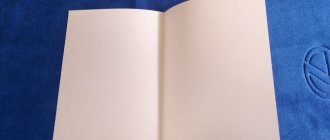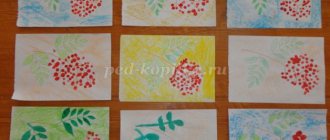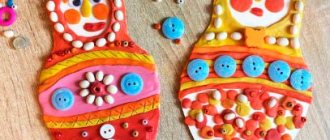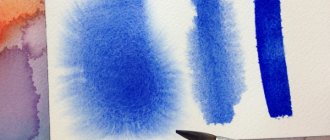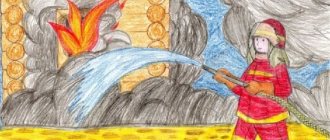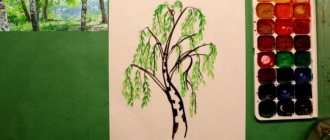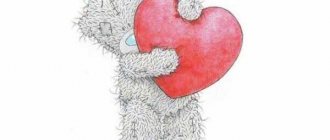Lesson 1. Cubes
Goals. Teach children to paint with stamps using wooden figures; navigate on a sheet of paper; clarify and consolidate knowledge of colors and shapes; develop interest and a positive attitude towards drawing.
Materials. Paints - gouache or watercolor; a large sheet of paper for a collective drawing, sheets of A4 paper (according to the number of children); wooden figures - cubes (with a smooth surface, not treated with varnish or paint); polyethylene covers; water in cans; rags, napkins; multi-colored cubes from a building set.
Technique. Drawing with a stamp.
Progress of the lesson
Prepare the paints and pour them into the lids. Before starting work, show the kids the colorful cubes. Tell them that today they will paint cubes.
Educator. Look what I brought you today. That's right, these are cubes. Let's not just draw, but print them. See how this can be done quickly and easily.
Show how to pick up a stamp cube, dip one side of it in paint, apply it to the paper and press down, then carefully lift it - a bright imprint will remain on the paper.
When changing paint, use a sponge to wash off the previous paint from the cube and wipe it dry with a cloth.
Invite the children to take turns printing the blocks on a large piece of paper. Monitor the consistency and quality of actions, if necessary, help and correct errors. At first, you should use one ink and print squares of the same color (so that you do not have to wash the cube before changing the ink). You can use several cubes - each for a specific paint.
Give the children paper and encourage them to print the blocks themselves. Help place the prints evenly over the entire surface of the sheet of paper.
Subsequently, teach children to apply paint to the surface using a brush. In this case, you can use several colors - each cube turns out to be different colors.
Lesson 2. Balls
Goals. Teach children to paint with a stamp using cut vegetables; navigate on a sheet of paper; clarify and consolidate knowledge of colors and shapes; develop interest and a positive attitude towards drawing.
Materials. Paints - gouache or watercolor; a large sheet of paper for a collective drawing, sheets of A4 paper (according to the number of children); carrots cut crosswise; polyethylene covers; water in cans; rags, napkins.
Technique. Drawing with a stamp.
Progress of the lesson
Before class, prepare the paints and pour them into the lids. Tell the children that during the lesson they will draw colorful balls.
Educator. Let's not just draw colorful balls, but print them. Now I will show how this can be done quickly and easily.
In front of the kids, cut a washed carrot of medium length and thickness in half, then show how to pick up half a carrot, dip the cut side into the paint, apply it to the paper, then carefully lift it - a bright imprint will remain on the paper. When changing color, wash off the previous paint from the cut surface of the carrot and wipe dry with a cloth. Accompany each step of the action with an explanation.
Have the children take turns printing circles on a large piece of paper. Monitor the consistency and quality of actions, if necessary, help and correct errors. At first, you should use one paint and paint circles of the same color (so that you do not have to wash the carrots before each change of paint). Or use several carrot halves, each for a different color.
Then give the children paper and encourage them to draw the balls themselves.
Subsequently, you can teach children to apply paint to the cut surface of carrots using a brush. In this case, use several colors - each ball will turn out to be different colors.
Lesson 3. Stars
Goals. Continue teaching children to draw using a stamp; navigate on a sheet of paper; clarify and consolidate knowledge of colors and shapes; develop interest and a positive attitude towards drawing.
Materials. Paints - gouache or watercolor; a large sheet of paper for a collective drawing, sheets of A4 paper (according to the number of children); several pieces of carrots cut across with an asterisk cut out on the cut; polyethylene covers; water in cans; rags, napkins.
Technique. Drawing with a stamp.
Progress of the lesson
Before starting the lesson, prepare the paints and pour them into the lids.
In front of the kids, cut washed carrots of medium length and thickness in half, then cut out a star on the cut (prepare several of the same shapes in advance). Show how to print figures using this stamp.
Invite the children to take turns printing stars on a large sheet of paper and come up with a plot for the drawing on their own - it could be flowers in a clearing, stars in the sky, or multi-colored holiday fireworks. You can use different paints.
Then give the children paper and invite them to print the stars themselves, coming up with a name for their drawing.
Lesson 4. Towers
Goals. Continue teaching children to paint with stamps using wooden cubes; maintain rhythm when using two colors; navigate on a sheet of paper, place the prints in a certain way relative to each other; clarify and consolidate knowledge of colors and shapes; develop interest and a positive attitude towards drawing.
Materials. Paints - gouache or watercolor; sheets of drawing paper in A4 format (according to the number of children); wooden figures - cubes (with a smooth surface, without varnish or paint); polyethylene covers; water in jars; rags, napkins; multi-colored cubes from a building set. Technique. Drawing with a stamp.
Progress of the lesson
Before class, prepare the paints and pour them into the lids.
Show the kids the cubes and ask them to build tall towers out of them, alternating two colors. When the towers are ready, compare them in height. Tell the children that today they will draw towers of blocks using paints on paper.
Show the children how to stack the prints on top of each other (in this activity, the paper is placed vertically). To make it easier for them, you can use one color at first, then alternate colors next time. You should also draw a line at the bottom of the sheet to indicate the surface on which to place the cubes.
Give the children paper and encourage them to print the towers themselves. If necessary, help position the prints one above the other.
How to draw Santa Claus?
On the eve of and during the New Year holidays, Christmas is a favorable period to teach your beloved child to draw Father Frost and his foreign brother Santa Claus.
During the long New Year holidays, parents will have time for such exciting and useful time together. Before you get creative, prepare:
- 2 sheets of paper;
- simple and colored pencils;
- eraser;
- ruler.
It is better if you sit down next to the child, reproduce the details of the drawing on your piece of paper, and the children do the same on the canvas. There's no need to rush. So that the child understands how to do it, we draw with the children step by step.
- Place a piece of paper in front of you vertically. Using a ruler and pencil, divide it in half vertically with a dotted line.
- Line it horizontally into four parts, drawing 4 dotted longitudinal sections.
- Under the second horizontal stripe, draw the head of Santa Claus. Draw the bottom of the fur coat symmetrically between stripes 2 and 3, don’t forget about the frill.
- Next you need to draw the sleeves and mittens.
- Draw the outline of his head, place the beard at the bottom, and the frill of the hat at the top.
- Draw the face step by step, don't forget about the mustache and eyebrows. The tip of the cap is located on the right, draw a round pompom here. Santa Claus has warm shoes and pants on his feet.
- When the full-length portrait is ready, erase the auxiliary dotted lines.
- Show your child how to paint the character’s mittens and shoes dark blue, and his pants and sheepskin coat red. Leave the beard, mustache, pompom, frills on clothes white, like the snow on which the hero of the canvas stands.
- To add contrast to the drawing, have the child fill in the background with a blue pencil.
Ways to organize children's activities
The fact that children love to draw is no secret. But for 3-4 year old children this doesn’t always work out successfully. Alternatively, you can use children's stamps. The ones bought in the store look like the real thing, which in itself arouses the interest of children. But the resulting drawings turn out to be characters from cartoons and fairy tales, parts of a single picture, for example a landscape, realities of our world that little ones are just getting acquainted with (vegetables, animals), funny emoticons, etc. A set of stamps can be selected or ordered individually for each child, depending on his age and interests.
Another thing is children's stamps made with their own hands. After all, if you initially involve children in this process, the seals will turn out exactly the way they want them to be.
"Flowers for Mom." Lesson notes on non-traditional drawing with stamps
Svetlana Stolyarchuk
"Flowers for Mom." Lesson notes on non-traditional drawing with stamps
Strengthen children’s ability to depict in drawings the structure of a flower (stem, leaves, petals)
using a variety of materials.
Educational: To introduce children to non-traditional drawing techniques - the technique of drawing “ stamps ”
.
Continue to learn how to make additions to the drawing that enrich its content. Use familiar drawing techniques when completing the drawing . Instill interest in an unconventional type of drawing .
Developmental: Develop aesthetic feelings, accuracy, imagination, creativity; ability to draw with different techniques .
Educational: To cultivate accuracy and composure when performing work techniques; listening skills; the ability to perceive the beauty of the surrounding world.
Develop skills of kindness and cooperation.
Equipment and materials: Picture “Spring”
, gouache, sheets of paper, napkins;
illustration of flowers , cotton swabs, bottle caps.
Planned results: Children learned about a new type of unconventional drawing - drawing “ stamps ”
Preliminary work: Reading fiction; memorizing poems and proverbs about mother; examination of illustrations depicting flowers , application “ Flowers in a vase ”
game
“Gardener”
, looking at illustrations of
flowers , drawing flowers using different techniques : circular movement of the brush, dipping.
Targets: The child shows curiosity;
inclined to observe and experiment.
Children are included in the group - welcoming children with guests!
Not only for play, but also for business
There are also functional children's stamps that will really help in life, but for adults. For example, parents, sending their children to kindergarten, school, or camp, often embroider their first and last names on their clothes - a kind of identification mark. You can get rid of this need for many years if you order a stamp with the child’s data. With its help, I put a mark on the back of the clothes - and the child will always be able to identify his pajamas or blouse.
A children's stamp will also help a teacher or primary school teacher. After all, they usually evaluate the work of their students with the help of drawings or funny faces. And with such an assistant it will be much easier and faster.
What are the benefits of using such stencils?
First of all, this is a very exciting activity for kids, which will help organize their leisure time for quite a long time. With children's stamps, children will learn about the realities of the world, develop imagination and creative thinking, and learn communication. It is also important that seals contribute to the development of fine motor skills, coordination of movements, and teach them to plan their activities.
Drawing with crumpled paper
Such images are created in two ways:
- A napkin or sheet is crumpled, dipped in paint, and with the help of such a simple device, prints are applied to the canvas.
- A sheet of paper is moistened with paint diluted in water. While the liquid has not dried, the canvas is blotted with a napkin, which leaves interesting outlines on it.
You can see in the photo how enthusiastically adults apply colorful stamps using soft paper and then turn them into drawings.
Therefore, this type of creativity can be done by the whole family, involving not only children, but also grandparents and friends.
The following ideas will also help you spend your leisure time together in an interesting and fun way.
How to draw a handsome Santa Claus?
As a result of step-by-step creativity, you will get it to be realistic and charming. The video at the end of the article will clearly show how to draw Santa Claus. Now you can, looking at a photo, depict your favorite character and invite your child to do it with you.
As you can see, there are 5 stages indicated in the photo; by reaching the last one, you will successfully complete the work.
The first photo shows that the Santa Claus diagram is first created. Here it consists of three figures. By drawing them, children will receive their first understanding of geometry.
Draw a small circle at the top of the sheet. To make the face that will fit in it symmetrical, draw a vertical stripe in this figure. A rectangle with beveled corners passes through the bottom of the circle. Soon he will become the body of Santa Claus. Its lower part is crossed by a semi-oval with a beveled bottom.
When talking about how to draw Santa Claus for children and with them, it should be noted that the activity should be exciting so that the children do not get bored. While portraying them together, you can tell your kids exciting New Year’s stories in which you will give the main role to the character you are portraying.
You can say that grandfather’s eyes should be painted as kind, he is like that - positive and fair. Draw facial features based on the hint in the second drawing. Looking at it, you will understand how to draw the base:
- beards;
- right and left hands;
- felt boots
Based on the tips of 4 photos, draw his hat, a bag with gifts, a magic staff, make the portrait more realistic.
Now you know how to draw Santa Claus with a pencil. Children usually love to color, so let them give color to the hero of the canvas, his clothes and accessories. If the child is small and is not yet able to draw Santa Claus, then he can color him with ease. It’s okay if the strokes of a colored pencil or chalk go beyond the boundaries of the contours. Be sure to praise the little artist so that he has a desire to continue to engage in creative work.
These kids will be interested in creating work using the technique of printing with palms or tree leaves.
Painting with salt
For creativity, in addition to it, you will need:
- a thick sheet of paper or cardboard;
- glue;
- brush.
If the child cannot yet create the outlines of the drawing on his own, do it yourself.
The landscape can be anything. For winter it is better to draw Santa Claus and Snow Maiden, forest, snowdrifts. If you want the canvas to depict planets in space or a starry night, then use cardboard or thick blue or black paper for the base.
The salt painting technique begins with dipping a brush into glue. They need to mark the details of the picture on paper. At the same time, do not skimp on glue.
Even a child can complete the next stage, but under adult supervision. Have him scoop up a handful of salt and sprinkle it on the drawing. It is better to use fine salt for snowflakes, and coarse salt for snowdrifts. When the entire canvas is covered with it, you need to carefully tilt the picture and pour in excess salt. As a result, it will remain only where it was intended and will indicate the details of the drawing.
You can leave it like this or dilute the paint in water and use a pipette to make blue drops on the picture. Wait a little, then you will see how spectacular the drawing has become.
Such painting techniques for children are very popular not only with them, but also with adults, who can first mix salt with food coloring and then create three-dimensional paintings like this one. Here is an autumn forest with a picturesque waterfall.
There are other interesting techniques for transferring images to canvas.
